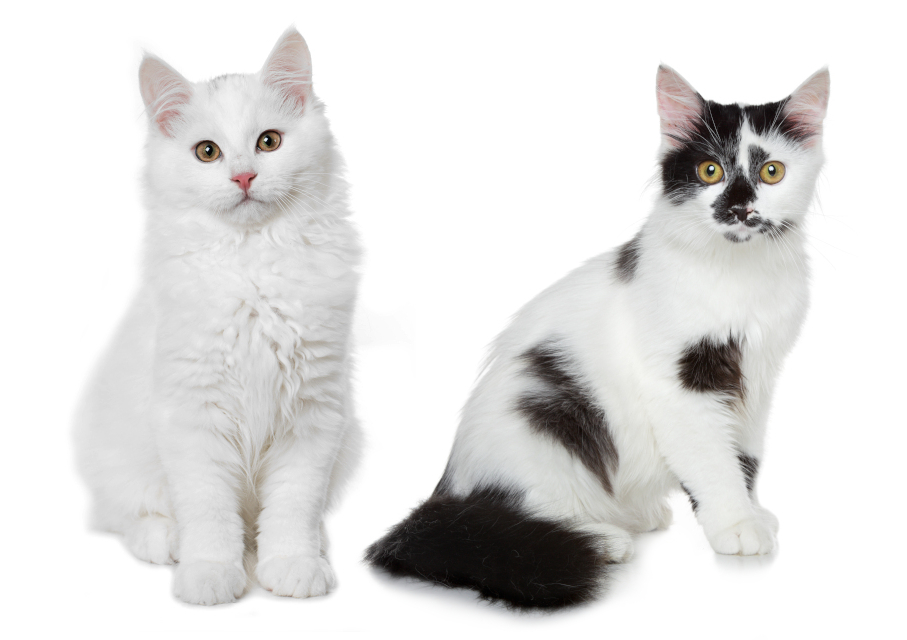Quick Summary

Click here for Price and Turnaround Time
Phenotype: The dominant white and white spotting variants cause white patterning in cats.
Mode of Inheritance: Autosomal dominant
Alleles: N = Normal or non-white, DW = Dominant white, Ws = White spotting
Breeds appropriate for testing: Many breeds
Explanation of Results:
- Cats with N/N genoytpe are not expected to be white (in the absence of albinism) and cannot transmit a dominant white or white spotting variant to their offspring.
- Cats with N/DW genotype will be white and may have some degree of hearing impairment. They will transmit this dominant white variant to 50% of their offspring, and those offspring are expected to be white.
- Cats with DW/DW genotype will be white and are likely to have some degree of hearing impairment. They will transmit this dominant white variant to all of their offspring, and all of their offspring are expected to be white.
- Cats with N/Ws genotype will have white spotting. They will transmit this white spotting variant to 50% of their offspring, and those offspring are expected to be white-spotted.
- Cats with Ws/Ws genotype will have white spotting. They will transmit this white spotting variant to all of their offspring, and all of their offspring are expected to have white spotting.
- Cats with DW/Ws genotype will be white and may have some degree of hearing impairment. They will transmit a dominant white variant to 50% of their offspring and a white spotting variant to 50% of their offspring.
Sample Collection:
Cat DNA tests are carried out using cells collected from your cat's cheeks and gums using household cotton swabs.
The cat DNA submission form with instructions, pricing, and a place to tape the cotton swabs can be printed from your home computer after signing up for a MyVGL account and placing an order. Test kits are not mailed.
Step-By-Step Instructions:
1.
 Purchase regular household cotton swabs for cat DNA collection (the cotton swabs can be purchased at a pharmacy or drug store)
Purchase regular household cotton swabs for cat DNA collection (the cotton swabs can be purchased at a pharmacy or drug store)
2.
 Use both ends of the two cotton swabs for a total of four swabs.
Use both ends of the two cotton swabs for a total of four swabs.
3.
 Collect the DNA sample by swabbing the cheek and gums of the cat.
Collect the DNA sample by swabbing the cheek and gums of the cat.
4.
 After swabbing the cheek and gums, tape the cotton swabs to the bar-coded submission form printed from your MyVGL account.
After swabbing the cheek and gums, tape the cotton swabs to the bar-coded submission form printed from your MyVGL account.
Dominant white (DW) and white spotting (Ws) are found across many breeds of cats and result from the insertion of a common “feline endogenous retrovirus” in the KIT gene. A full 7125bp insertion results in white spotting while a partial insertion results in dominant white. As white spotting is a dominant trait, only one copy of the full insertion is required for the white spotting color pattern when the other allele is wild-type. While the extent of white spotting is not definitively associated with copy number, anecdotal evidence suggests that two copies of the white spotting insert results in more white. The pattern of white spotting does not correlate with one or two copies and the gene/genes controlling the pattern of white spotting remain unknown. Additionally, not all white spots or patterns result from these alleles as other genes can also have mutations that result in depigmentation phenotypes.
One or two copies of the partial insert results in the dominant white (DW) phenotype regardless of the other allele. Dominant white is distinct from albinism (ca) which results from a mutation in a different gene that has no known impact on hearing. While one or two copies of the DW allele will result in a white cat, varying degrees of hearing impairment are observed. In an extended pedigree, nearly 75% of cats with two copies were deaf and the remainder had at least partial hearing impairment. In cats with a single DW copy and a normal copy for the other allele nearly 60% had normal hearing, 21% were deaf and 17% had hearing impairment. In cats with one copy of DW and one copy of white spotting (Ws), 1/3 had normal hearing, 1/3 had impairment and 1/3 were deaf.
Testing for dominant white and white spotting mutations helps clarify the genetic basis for depigmentation patterns in the cat. This test is recommended for multiple breeds as well as random bred cats.
